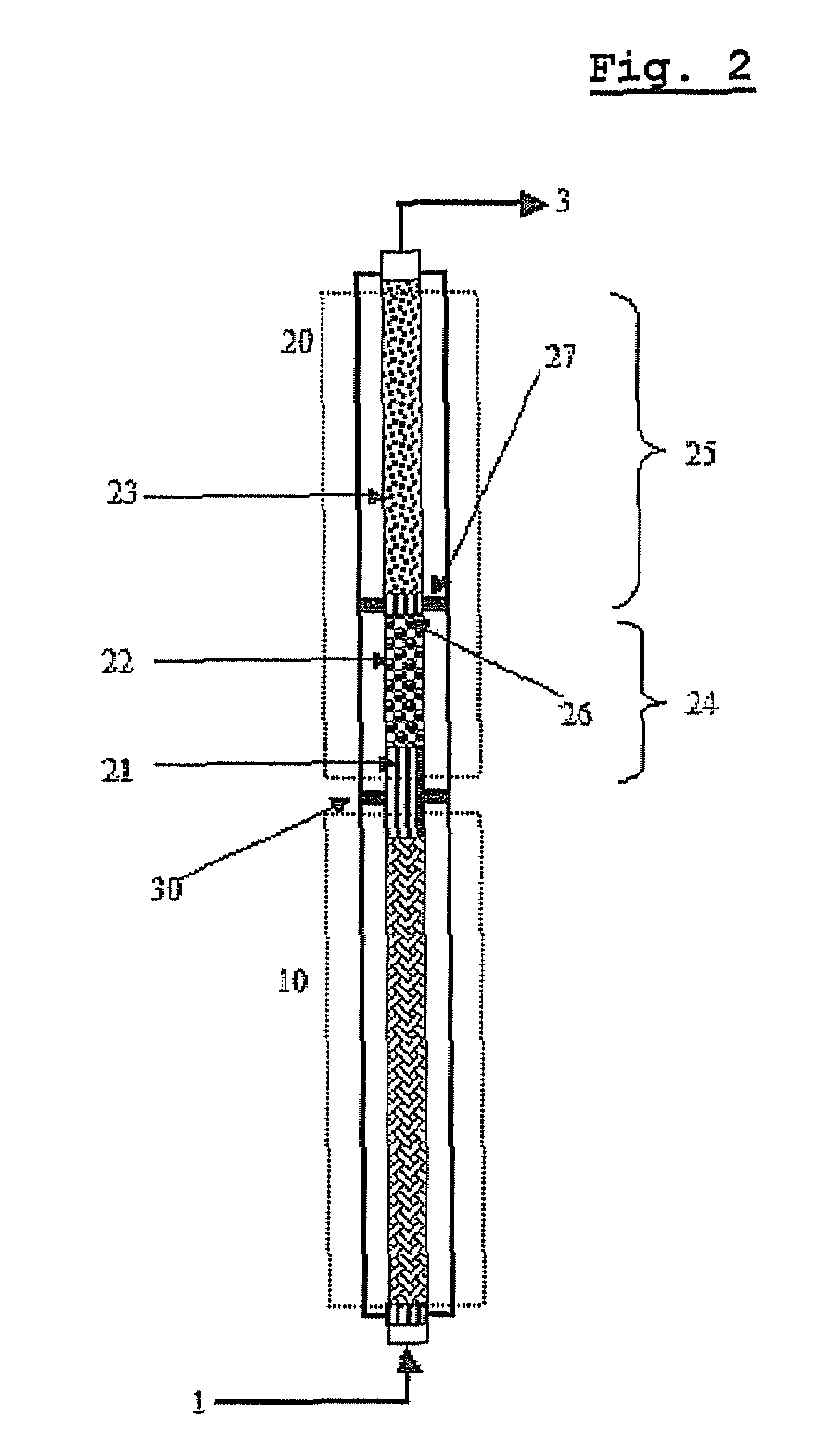Method of producing unsaturated acid in fixed-bed catalytic partial oxidation reactor with high efficiency
a technology of unsaturated acid and catalytic partial oxidation, which is applied in the preparation of carboxylic compounds, indirect heat exchangers, lighting and heating apparatus, etc., can solve the problems of increased production, reduced yield of (meth)acrylic acid, and difficulty in controlling the resultant reaction temperature, so as to suppress side reactions, reduce the magnitude of peak temperature in the first shell space, and inhibit heat accumulation
- Summary
- Abstract
- Description
- Claims
- Application Information
AI Technical Summary
Benefits of technology
Problems solved by technology
Method used
Image
Examples
reference example 1
Determination of Lowest Active Temperature of Catalyst Layer Corresponding to First Shell Space of First Step
[0087]A pilot reactor in which the first step is conducted in one catalytic tube was provided. The catalytic tube had an inner diameter of 26 mm. In the first-step catalytic tube, a catalyst layer was packed to a height of about 1200 mm. At this time, two kinds of catalysts having activity increasing along the axial direction from the inlet to the outlet were packed to a height of 320 mm and 880 mm, respectively (see “Method of Controlling Catalytic Activity” described in U.S. Pat. Nos. 3,801,634and 4,837,360). The catalyst was comprised of the first-step oxidation catalyst material obtained according to the method as disclosed in Korean Patent Publication No. 0349602 (Korean Patent Application No. 10-1997-0045132), the catalyst material being based on molybdenum (Mo) and bismuth (Bi).
[0088]The first catalyst layer (referred to as LGC1 hereinafter) of the first-step reaction ...
example 1
Variations in Yield and in Magnitudes of Temperature Peaks at Hot Spots Depending on Variations in Temperature Setting of Molten Salt
[0096]As shown in FIG. 1, a pilot reactor was provided in which each of first-step reaction and second-step reaction is conducted in one catalytic tube (included in zone 10 or 20 of FIG. 3). The catalytic tube had an inner diameter of 26 mm, and the first-step catalytic tube was filled with catalyst layers to a height of about 1200 mm, and the second-step catalytic tube was filled with catalyst layers to a height of about 1100 mm.
[0097]In the catalyst layers of the first step reaction zone 10, two kinds of catalysts having activity increasing along the axial direction from the inlet to the outlet were packed to a height of 320 mm and 880 mm, respectively (see “Method of Controlling Catalytic Activity” described in U.S. Pat. Nos. 3,801,634 and 4,837,360) . In the catalyst layers of the second-step reaction zone 20, two kinds of catalysts having activity...
example 2
Variations in Yield and in Magnitudes of Temperature Peaks at Hot Spots Depending on Variations in Temperature Setting of Molten Salt
[0107]This example was performed in the same manner as described in Example 1, except that the temperatures of the molten salt in the first-step reaction zone (first-step reactor) were set to 300° C. and 315° C., respectively, in an axial direction. In the first shell space of the first step, the value defined by Equation 1 was about 1.9.
[0108]In the zone corresponding to the first shell space in the first-step reaction zone, a hot spot with a temperature of 381.2° C. was generated. The yields of acrolein and acrylic acid were 79.02% and 11.46%, respectively. In the second-step reaction zone operated under isothermal conditions, the temperature of a hot spot was 327.5° C., and the yields of acrolein and acrylic acid were 0.607% and 84.95%, respectively.
PUM
| Property | Measurement | Unit |
|---|---|---|
| temperature | aaaaa | aaaaa |
| temperature | aaaaa | aaaaa |
| temperature | aaaaa | aaaaa |
Abstract
Description
Claims
Application Information
 Login to View More
Login to View More - R&D
- Intellectual Property
- Life Sciences
- Materials
- Tech Scout
- Unparalleled Data Quality
- Higher Quality Content
- 60% Fewer Hallucinations
Browse by: Latest US Patents, China's latest patents, Technical Efficacy Thesaurus, Application Domain, Technology Topic, Popular Technical Reports.
© 2025 PatSnap. All rights reserved.Legal|Privacy policy|Modern Slavery Act Transparency Statement|Sitemap|About US| Contact US: help@patsnap.com



